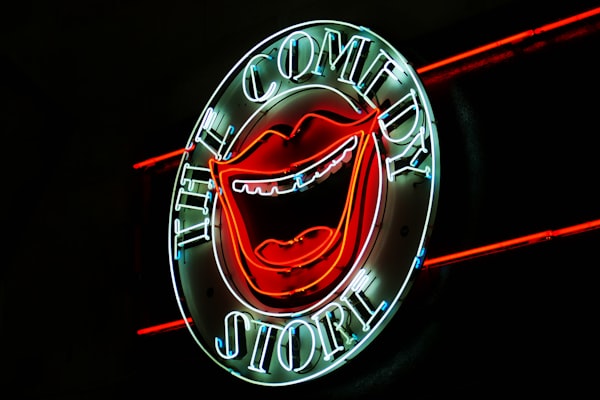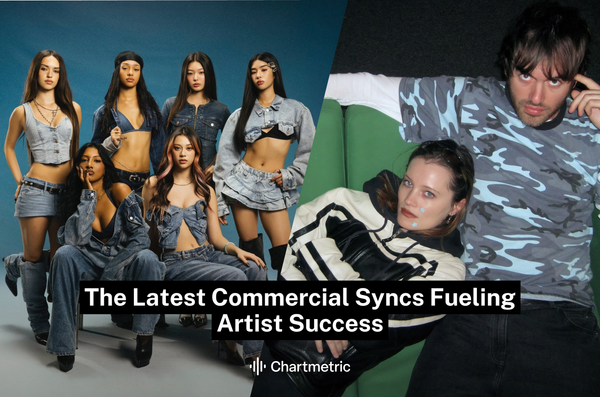“Comedians are acting not just as joke-tellers, but as truth-tellers—as guides through our cultural debates…. Comedy, like so much else in the culture, now exists largely of, by, and for the Internet. Which is to say that there are two broad things happening right now—comedy with moral messaging, and comedy with mass attention—and their combined effect is this: Comedians have taken on the role of public intellectuals.” - The Atlantic
If you’re lucky enough to find yourself in a live comedy venue, surrounded by drunk patrons and fart jokes, it might be hard to take a step back to look at the role comedy plays in society in 2022. But for many, it’s in these spaces where we wage the invisible war of social norms, under the cover of laughter. Likewise, while social media today is arguably the epicenter of such civil discontent, it may also be where you saw another comedian’s bit about immigration or gay rights, possibly reframing the way you thought about a recent controversial news headline.
It’s beyond the scope of this article to understand our need to laugh, to let loose of our societal norms once in awhile, and to be entertained by storytellers. But just as music can reach an emotional depth in a way words alone can’t, a comedian’s words can sometimes guide a crowd down a path that music lacks the language for. That’s also an art form worth supporting.
“Comedy doesn’t change the world, but it’s the bellwether.... When society is under threat, comedians are the ones who get sent away first.... Comedy survives every moment.” - Jon Stewart, former "Daily Show” host and 23rd recipient of the Mark Twain Prize for American Humor
As the world of comedy spreads its tentacles into music streaming platforms (e.g., Spotify, Apple Music) by way of comedian-owned podcasts, or in the form of stand-up specials produced by streaming video-on-demand companies (e.g., Netflix, Amazon Prime), comedic talent is increasingly visible via digital platforms where they can command their own crowd directly. While a stage is still very much where the rubber meets the road, just like a music artist performing live for their fans, these comedic acts are literally giving voice to the more nuanced and complex issues we face today in society.
Platforms to Find Laughs
Comedy in the digital world is its own animal, distinct from music artists. Arguably, the indisputable platforms of choice are Instagram (for newer comedians) and Twitter (comedy's traditional social platform). The design of both (e.g. standup clips on Instagram Stories and Reels, hot takes on trending Twitter topics) are almost tailor-made arenas for a comedian to nurture their brand. TikTok is increasingly a platform of choice due to its massive and still growing popularity, as well as its video-first mentality. YouTube content will always be relevant, as the most well-established video platforms of them all, and a place for evergreen content to live on as a comedic CV of sorts.
Knowing the importance of these platforms for comedians, we can explore how comedians and their business teams can make better informed decisions when it comes to growing their audience, routing a tour, negotiating a brand deal, etc. Within the Chartmetric analytics platform, there are 17K+ artists tagged with the “Comedy” genre. Using the Artist Filters tool in the Artist List, you can explore 7.5M+ artists (mostly musical) worldwide.
Because Chartmetric Artist Score and Chartmetric Artist Rank are a proprietary daily global digital artist popularity index, most tables in the app default to sorting in this metric. However, it is optimized for popularity from a musical act perspective, which skews toward digital streaming metrics like monthly listeners and playlists. In the comedy world, it’s more about ticket sales and/or brand partnerships, so using Chartmetric’s social media data is of better use.
For example, if we examine the Top 50 music artists on Instagram, you’ll see that the tip of the spear are celebrities of several industries (e.g., Selena Gomez, Dwayne Johnson, Zendaya.) Less than 80M followers, the population starts to show a smoother drop-off, though that doesn’t mean the stars are any less bright (e.g., Priyanka Chopra, Shawn Mendes, BTS).
Juxtaposing this with the Top 50 comedic acts by Instagram followers suggests comedy is more specific in its audience (a “long tail”). After the first few outliers (e.g., Kevin Hart, Ellen DeGeneres, King Bach, Jimmy Fallon, Joe Rogan), it’s only less than 10M followers where we see a more even drop-off. We see a similar distribution on Twitter as well: Music acts have bigger and more distributed audiences, while comedic acts have a handful of huge stars, then quickly drop off into smaller audiences.
From an industry-level, it could very well be true that music is simply “bigger” than comedy, but it doesn’t help that comedians’ output is harder to track in this connected information age. Musicians’ work has been highly visible via streaming platforms for years now, and their recorded music is essential to their business. Meanwhile, comedians’ main work exists either in the context of some bigger entity (e.g., TV series, a killer set at a club among several comics) or when it’s their own work (e.g., Netflix special, advertising-supported podcast, headlining tour), so the success metrics are private.
In a lot of ways, music has been known to be the first entertainment sector to be bloodied by technological change, with all others (e.g., comedy, film, TV) following after. Ed Rivadavia, Chief Marketing Officer at 800 Pound Gorilla Media (label partner for Netflix, Kevin Hart’s LOL Network, Bill Burr's All Things Comedy, etc.) and former VP of Digital Strategy at Sony Music Entertainment, took two decades of music industry experience and applied it to the world of comedy. "I'd say comedy was a few years behind music in terms of social media savvy and adoption ... for a multitude of reasons. One of them being that labels and musicians saw their business radically disrupted by Napster 20 years ago, and were forced to cope with the ensuing technological advancements, while comedy and other entertainment verticals followed music's lead. The most obvious example being the rise of audio streaming and then the recent video streaming boom. Now, with the rise of TikTok, I see many comedians wisely shifting their social media priorities away from the older social platforms... and there's also an entirely new breed of comedian emerging from the short-form video platforms, who will redefine comedy based on that consumer experience."
Knowing comedy marketing is modernizing quickly, social media now be a place where, just like musicians, comedians and their teams can formulate plans to grow their careers.
Finding A Comedian’s Audience on Instagram
In an era where K-Pop and Latin acts now regularly win American music awards, Hollywood arguably believes that comedy doesn’t “travel well." Language and culture are understandable barriers when we all have different senses of humor, politicians to skewer, or current issues to debate. Knowing this, Netflix famously used the 2010s to dominate the international stand-up comedy market by throwing millions of dollars around the world to strategic markets (and the comedians in them) as a way to expand its subscriber base, for a fraction of the cost of an expensive TV series or original film (though they certainly did that, too). As such, it’s important for comedians to understand who they’re connecting with and where they may be.
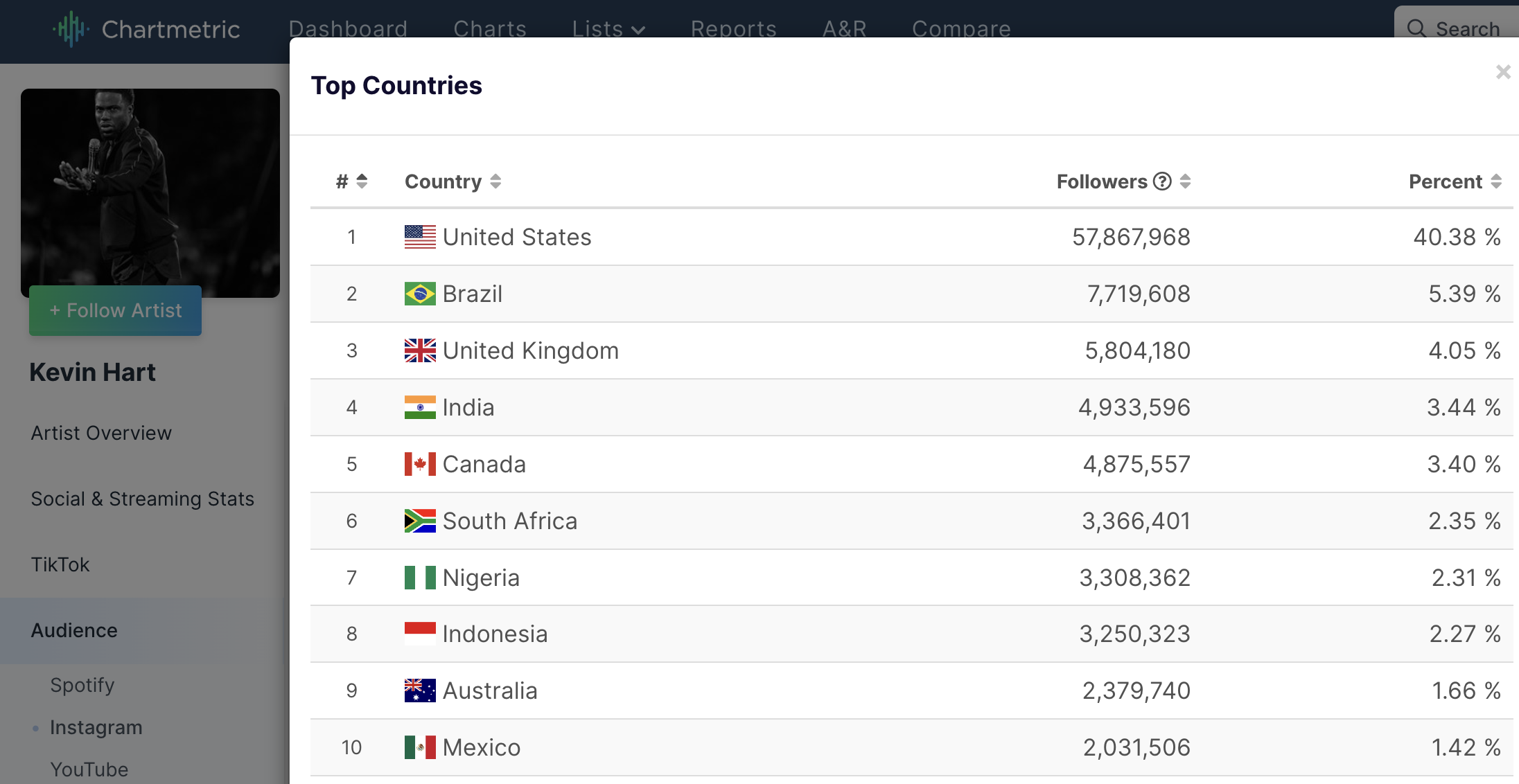

From a geographical perspective, a promoter could pay for an American star like Kevin Hart (143M total Instagram followers) to play a show in another country like Brazil (where he has 7M Instagram followers). Or, they could go with one of their own, like Brazilian star Whindersson Nunes, who has less than half that follower base total, but 54M of them are in Brazil (he's also the most popular comedian on YouTube with 4B+ views). Home court advantage is real, and the proof is in online audiences and ticket sales.
Geography also plays a part in the more practical parts of a comedian’s career, i.e., when it comes time to plan a tour. In this sense, it’s no different from how a musician would do it. While the genre of music many times will play a part in how relevant a digital audience translates to in-person (e.g., jam-band audiences couldn't care less about streaming numbers), just understanding where a comedian has potential to sell out venues of a certain size is key to the planning process.


Looking at Iliza Shlesinger’s TikTok account (780K followers at the time of writing), it’s clear the Anglosphere countries of US, UK, Canada, and Australia are all great places for her to work in, especially when combined with her Instagram follower fanbase (819K). It’s always good to corroborate insights across platforms.

Once drilling down to Shlesinger's Instagram audience at the city level, we get down to the brass tacks of what size venues are possible in what locales. While the hard numbers are only suggestions (ticket sales are their own beast), the proportions of the data can help her team make smarter decisions.


Cross-referencing platforms never hurts because you are adjusting for the platform’s own user base, which has its own skew independent of the talent in question. At first glance, you’d guess Shlesinger’s main TikTok fanbase is 18-24/Gen-Z women. But looking at her Instagram audience, her overall "in-real-life" audience at least includes the 25-34 age range as well (even there, Instagram skews towards older millennials). This doesn’t mean she doesn’t have any older, or male, fans, but it does contextualize her audience a bit more (which is useful in itself for native digital marketing campaigns).
Measuring New Release Effects Across Platforms
“We want [our users] to find a special that speaks to them in a personal way. The end goal is to hear jokes from more people all over the world.” - Robbie Praw, director of original stand-up comedy programming at Netflix, The Hollywood Reporter (2019)
Like most music artists, when a comedian comes out with new material, it’s a big moment for them. More than likely, large sums of marketing money are going toward the publicity of these events, especially when it’s a Netflix special. As mentioned earlier, Netflix holds a special place in the comedian world, as “Netflix has paid comics anywhere from $50,000 to $20 million for a single one-hour special, with the most common price tag now about $500,000, say agents and producers who have worked with the streamer.” Being able to track a new special’s effects across a comedian's various platforms is key to understanding how effective these campaigns are, as that Netflix moment ideally should translate to selling live tickets, and tracking signals on their socials is a good lead indicator for that.

Going back to Iliza Shlesinger, her label 800 Pound Gorilla Records released her 2020 Netflix special Confirmed Kills on July 16. Her TikTok profile showed her first uploading material in April 2020, warming up with funny clips at home featuring her dog. Beginning on June 27, her first Confirmed Kills clip debuts, and it goes hard on that campaign through the global release date — and past it.
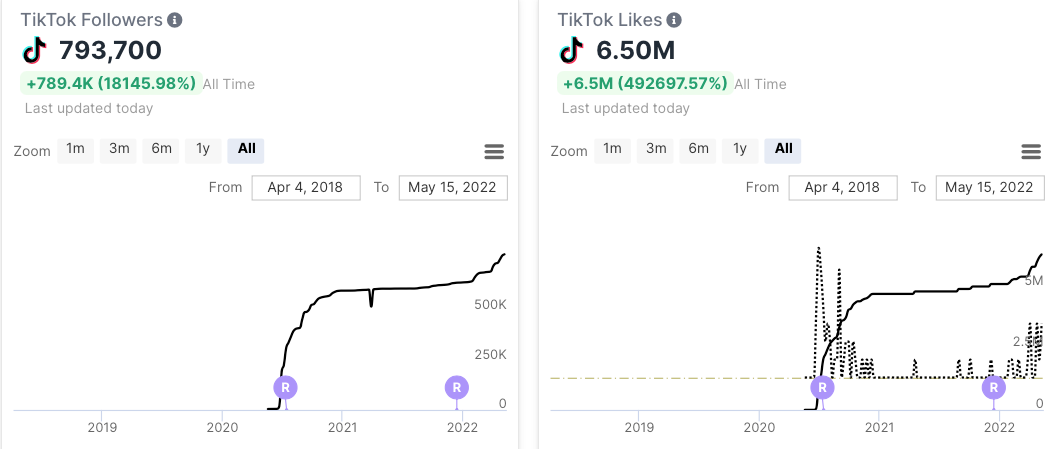
The aftermath is clearly evident on her TikTok profile, which is something Shlesinger wholly owns and can leverage for her own campaigns for other projects.
Tracking Other Comedic Viral Moments on TikTok
@fluffyguy Happy Wednesday :) #gabrieliglesias #Letmegetmyglasseson #ohitsabitch ♬ original sound - Gabriel Iglesias
Speaking of TikTok, it’s now evolved past its initial dance meme phase, and music artists’ tracks continue to find viral moments through the videos of TikTok influencers. For comedians, however, the platform is great for themselves as the attention draw, and a Netflix special does not need to apply for special moments.
"One of the unexpected challenges TikTok and the overall short-form video boom has thrown at musicians is that so much of the content is, first and foremost, FUNNY. And far too many musicians take themselves a little too seriously, whereas comedians obviously make a living out of laughter," Rivadavia notes. "So while established comedians understandably needed information and education to recognize the promotional power and creative opportunities provided by TikTok, more and more are now using it to expose their work to new fans, and turn that discovery into streaming revenues on DSPs like Spotify, Apple Music, Pandora, etc. I was fortunate to contribute to this transition over the past two years, and I'm seeing a similar snowball effect for Comedy + TikTok in 2022 that I witnessed in music in 2019 and '20."
In the case of Gabriel “Fluffy” Iglesias (Forbes’ 2018 highest-paid comedians Top 10, raking in an estimated $20.5M from 100+ live shows plus a three-project Netflix deal), while he already commanded 4.6M TikTok Followers, on January 12, 2022, he posted his own version of the #ohitsabitch and #letmegetmyglasseson meme on his profile.
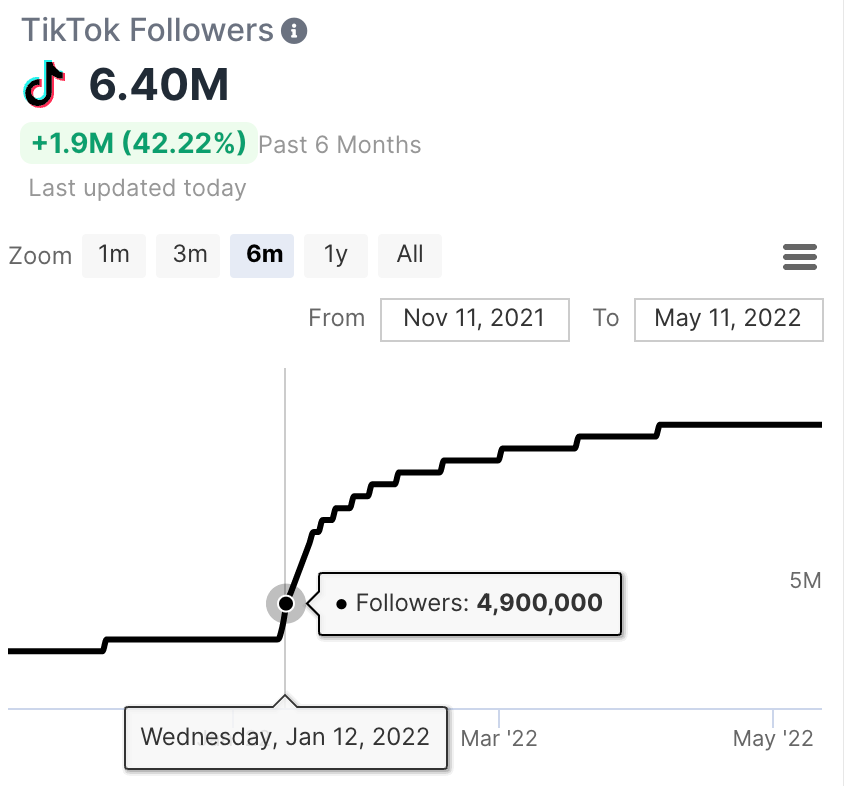

The 8-second post garnered 71.5M views, 6.8M likes, and 47K comments (at the time of writing), and significantly boosted his profile over the following month. While not every comedian enjoys the established following Iglesias does, what TikTok does provide is an environment that strongly favors content, on each video's own merits. A celebrity's half-baked upload could easily be overshadowed many times over by an unknown comedian's super-engaging first TikTok. Checking other metrics like engagement rate (average likes divided by follower count) and notable followers will help give a comedian ideas on how much their viewers are into their content, not to mention possible influencers for collaboration and expansion into new audiences.


The Data Says ... Comedy is Here to Stay
In the US, every generation seems to spawn its own class of town criers, and it seems today’s complex world has given us a different kind of comedian. In the 1990s-2000s, the youth of America turned to Tupac, Nas, The Notorious B.I.G., Wu-Tang Clan, Public Enemy, NWA, Snoop Dogg, Dr. Dre, and other rap luminaries to understand what our country was really like in our streets. Before that, the singer-songwriters of the 1960s and '70s (Marvin Gaye, Joni Mitchell, Stevie Wonder, Aretha Franklin, Bob Dylan, James Brown, Nina Simone, Harry Belafonte, Woody Guthrie, and John Lennon) similarly used their craft to speak out against the Vietnam War, racism in America, and numerous social issues we still struggle with today.
While comedians go out and make us laugh, it will be fun to understand who it is they’re connecting with. What issues are being discussed? What topics are being batted around? The data we see play out here on social media platforms like Instagram, Twitter, and TikTok are showing us the results of comedians plying their trade.
After every show, after every social media post, after every deal made with a production company, there’s a chance now to watch a new generation of artists give voice to the world we live in — fart jokes included, of course.

